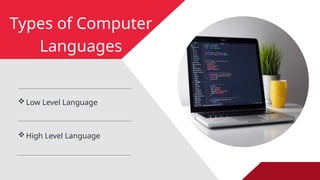Computer Topic (Introduction to Programming).pptx
- 1. UNIVERSITY INSTITUTE OF TECHNOLOGY PARACHINAR Computer Programing Course Instructor: Javed Ali
- 2. Computer Program Writing a Program Solving Problems Computer Language Types of Computer Languages Compiler & Interpreter Contents
- 3. Computer Program Software refers to programs that make the computer perform some task. A program is a set of instructions that tells the computer what to do. When you have written a program, the computer will behave exactly as you have instructed it. It will do no more or no less than what is contained in your specific instructions.
- 4. Writing a Program Learning to write programs requires two skills. 1. You need to use specific terminology and punctuation that can be understood by the machine; that is, you need to learn a programming language. 2. You need to develop a plan for solving a particular problem. This plan or algorithm is a sequence of steps that, when followed, will lead to a solution of the problem.
- 5. Solving Problems Initially, you may think that learning a language is the more difficult task because your problems will have relatively easy solutions. Nothing could be further from the truth! The single most important thing you can do as a student of computer science is to develop the skill to solve problems. Once you have this skill, you can learn to write programs in several different
- 6. Computer Language A microprocessor is designed to “understand” a set of commands called an “instruction set” All instructions must be provided to the CPU in its native language, called machine language. All data transmission, manipulation, storage, and retrieval is done by the machine using electrical pulses representing sequences of binary digits. If eight-digit binary codes are used, there are 256 numbered instructions from 00000000 to 11111111.
- 7. Types of Computer Languages Low Level Language High Level Language
- 8. Low Level Language Machine Language and Assembly Language are both called low level languages. In a low-level language, it is necessary for the programmer to know the instruction set of the CPU in order to program the computer. Each instruction in a low level language corresponds to one or only a few microprocessor instructions. Advantages Instructions can be written to enable the computer to do anything that the hardware will follow. Require less memory Run more quickly
- 9. High Level Language A high-level language is any programming language that uses words and symbols to make it relatively easy to read and write a computer program. Many high level languages have been developed. Examples: Fortran, Cobol, Python, Pascal, C, C++, Java, and others Advantages Reduce the number of instructions that must be written. Allow programs to be written in a shorter amount of time. Reduce the number of errors that are made, because the instructions are easier to read.
- 10. Machine Language Machine Language Instructions written in this form are referred to as machine language. It is the native language that the CPU “speaks” and “understands”. It is possible to write an entire program in machine language. However, this is very time consuming and difficult to read and understand. Assembly Language Assembly Language Assembly language uses letters and numbers to represent machine language instructions. An assembler is a program that reads the codes the programmer writes in assembly language and “assembles” a machine language program based on those codes. However, assembly language is still difficult to read.
- 11. Comparing Machine Language & Assembly Language Machine Language 010000110011101000111 101010000010010101101 000010. For example, the code for both for adding two integers might be: Assembly Language LOAD A ADD B STORE C This causes the number in A to be added to the number in B, and the result is stored for later use in C.
- 12. Interpreter & Compiler Programmers writing in a high-level language enter the program’s instructions into a text editor. The files saved in this format are called text files. A program written in a high-level language is called source code. The programs are translated into machine language by interpreters or compilers. The resulting machine language code is known as object code.
- 13. Interpreter An interpreter is a program that translates the source code of a high-level language into machine language. Each instruction is interpreted from the programming language as needed (line by line of code) Every time the program is run, the interpreter must translate each instruction again. In order to “run” the program, the interpreter must be loaded into the computer’s memory.
- 14. Compiler A compiler is another program that translates a high-level language into machine language. A compiler makes the translation once so that the source code don’t have to be translated each time the program is run. The source code is translated into a file called an object file. A program called a linker is used to create an executable program. Most modern compilers let you compile and link in a single operation, and have an “IDE” (Integrated Development Environment) to enter text, debug, compile, link, and run programs.
- 15. Bug and Debug Bug: An error in coding or logic that causes a program to malfunction or to produce incorrect results. Debug: To detect, locate, and correct logical or syntactical errors in a program.
- 16. Thank You















